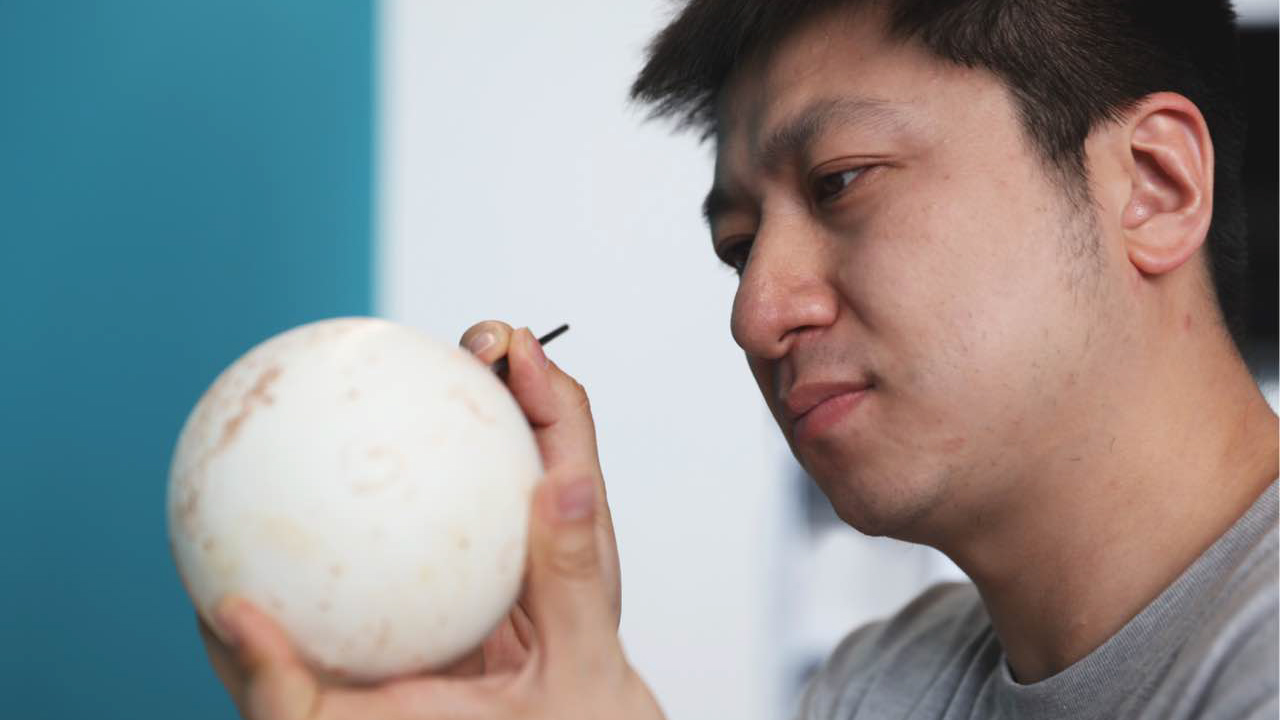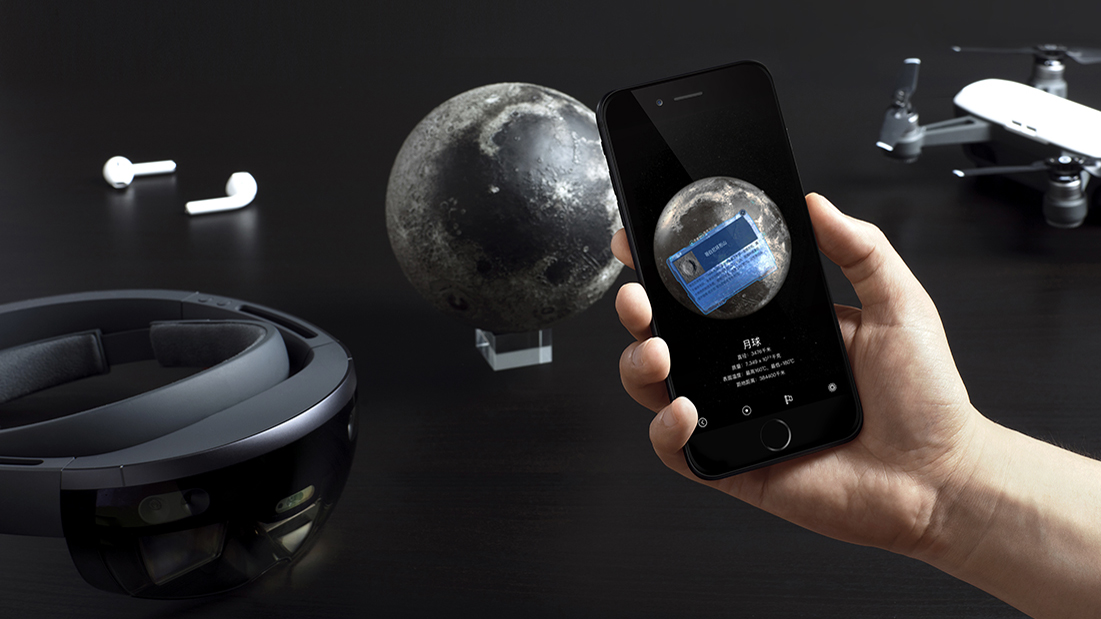We took an AR trip to the moon
The moon, and its secrets, in your hand

Whether it’s the proliferation of science-fiction movies that show man exploring the stars, or bold claims from the likes of Elon Musk and Stephen Hawking about imminent space colonization, there’s a collective interest in space right now that doesn’t look like it’ll die down anytime soon – or at least not until we’ve set up camp on Mars.
But how much do you really know about the universe? Unless you’re a serious astrophile, the chances are you do little else than look at cool photography, follow Nasa on Instagram (if you don’t, you seriously should) and retweet nuggets of Elon Musk’s wisdom about taking us all to space.
A company called AstroReality wants to change all that, and deliver education about space that’s more accessible, interactive and tech-enabled than ever before – and there isn’t a dull textbook in sight.
Lunar ambitions
AstroReality has big, bold plans about space education. But the company’s first creation is an extremely detailed version of the moon called the AstroReality Lunar. Although the model itself is extremely cool, and would look damn fine on your desk, there’s a lot more to it than looks.
The company claims it’s the most precise model of the moon on this planet, and certainly the only AR-enabled one that’s this detailed. The team at AstroReality have mapped the most famous moon spots on the model, which you can explore with AR tech and a dedicated smartphone app.

It created the model using data from Nasa, state-of-the-art design tools and sophisticated 3D printing tech. Look closely and you’ll see the craters Copernicus and Petavius – and 2001: A Space Odyssey fans will be happy to spot Clavius too (just be sure to put some ear muffs on before you head down into the crater).
We tested out the prototype for ourselves. All you have to do is let the app track the surface in front of you with a QR code and labels about sites around the moon pop up in front of you, with the features set to get more advanced over time.
Sign up for breaking news, reviews, opinion, top tech deals, and more.

There are three different versions of the AstroReality Lunar: the Mini at 3cm, the Regular at 8cm and the Pro, which comes with more feature, at 12cm.
It’s a great way for people to, quite literally, get to grips with space, and it’s not hard to imagine who might benefit from an interactive, AR-enabled model like this, from those who are just interested in space to kids in an education setting.
But although the Lunar model is fascinating, it’s only the start for AstroReality. We spoke to James Li, founder of AstroReality, about what the future holds for his moon models, AR and learning about space.
How to build a moon
The process of creating the Lunar was a painstaking one. “We used [digital modeling tool] Zbrush to design the Lunar model integrating Nasa’s Lunar Reconnaissance Orbiter’s data early on in our process,” Li explains.
“Data is downloaded from NASA LROC – the Lunar Reconnaissance Orbiter Camera, or LROC, is a system of three cameras mounted on the Lunar Reconnaissance Orbiter (LRO) that capture high-resolution black and white images and moderate-resolution multi-spectral images of the lunar surface. We leveraged the high-resolution Elevation Map and Global Map.”
This promotional video shows the process…
After creating a version of the moon that’s modelled to 0.006 millimeters per pixel precision, it was time to pack it full of AR smarts. “We created three tiers of AR experiences,” Li told us. “We used [game engine] Unity and [AR platform] Vuforia AR SDK for front-end and [cloud platform] Microsoft Azure for back-end data, specific for the three sizes we offer for Lunar in.”
From moon landmarks to moon landing
Right now if you get the Lunar model and the app you can see labels of the key craters and sites. But there’s going to be much more to the AstroReality Lunar over the coming months.
“The second stage will be to see and learn about landmarks that we know about but we have never visited before – the dark side of the moon revealed,” Li tells us. “The third part is to simulate a mission to the moon, with the ability to land on all the Apollo landing stations 11 through to 17, and to travel through the moon listening, learning, watching and reading about the historic landmarks visited by the astronauts on the Apollo missions. This is where we tell the story and you can personalise your journey.”

From there there’ll be more locations added, a game-like element introduced and way more interaction. And it’s not just the moon that AstroReality wants to help us understand better – the company already has a mini solar system set, and plans to roll out an entire solar system of larger, more interactive models in the future.
On a mission to inspire
“Lunar will add another dimension to learning in the classroom, as it’s interactive using rich media and advanced AR technology, all of which have been proven to keep children engaged with their learning,” Li says.
“But it’s not just a toy – the data and scale are so precise that it’s an excellent tool for professional scientists in laboratories and research centres to visualize the moon.”
And Li and the team at AstroReality want this knowledge will come in handy much quicker than we all expert.
“At the Breakthrough Starshot conference last month, Stephen Hawking set a deadline of 100 years for humans to start colonizing another planet for us to survive climate change, deadly diseases and other fatalities,” Li explains.

“AstroReality models will educate everybody to help them understand space, be more familiar with it and make this statement less of a daunting one. As humans our imaginations have always run wild with space and astronomy; now AR allows us to experience it as closely as possible without being there.”
We’re not sure that AR tech will answer the big, logistical questions about how we get everyone up in space or colonise other planets. But we’re all for the idea of more and more people learning about space and the possibilities it might hold for the future.
Finally, we wanted to hear what Li thought about the future of AR and VR when it comes to learning. “It’s already happening, but I expect to see a surge of augmented reality and virtual reality combined in mixed reality experiences in education,” he says.

“This will be the case in classrooms to add more interactivity into education and at Astronaut training camps for those on their way to space. This is the closest people will get to going to the moon without actually getting on a rocket; it will fulfil so many lifelong dreams and prepare those on a space mission for the real thing.
“But ultimately, AR VR and MR is the future of so many industries, astronomy and science included.”
And after spending so much time researching, designing and engaging with the moon, we asked Li what his favourite bit of lunar geography is. “Copernicus,” he says. “I can see Copernicus with my bare eyes from Earth every time I look at the moon – it’s almost right in the middle. Its pattern is complex and goes in various directions. When I painted Lunar, Copernicus is the one that I spent the most time on.”
AstroReality is currently seeking crowdfunding for Lunar on Indiegogo, with discounts on its models for backers.

Becca is a contributor to TechRadar, a freelance journalist and author. She’s been writing about consumer tech and popular science for more than ten years, covering all kinds of topics, including why robots have eyes and whether we’ll experience the overview effect one day. She’s particularly interested in VR/AR, wearables, digital health, space tech and chatting to experts and academics about the future. She’s contributed to TechRadar, T3, Wired, New Scientist, The Guardian, Inverse and many more. Her first book, Screen Time, came out in January 2021 with Bonnier Books. She loves science-fiction, brutalist architecture, and spending too much time floating through space in virtual reality.